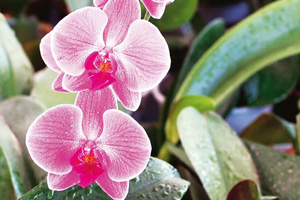The first time that plants were included in the IUCN’s (World Conservation Union) Red List was 1997. That year, numbers revealed that nearly 380 species had become extinct in the wild and nearly 370 were considered threatened. However, it was only a first approach, as this list only included vascular plants (ferns, conifers and flower bearing plants).
According to the 2007 IUCN Red List, of the 12,043 classified plants, 8,447 are considered threatened species. In sectors like Central and South America, central and western Africa and southeast Asia, endemic plant organisms are decreasing at an unexpected rate.
The same happens with the plants that inhabit islands around the world. Recognized as unique spaces when it comes to biodiversity, the insular territories of different countries marvel with the amount of unique species, both animal and plant, that inhabit them. This way, several organisms that also populated the continents where they couldn’t withstand the aggressions of human activities in earlier times, only survived in these real natural shelters. However, today, the situation is critical because most of the endemic plants of the islands are under the threat of extinction.
The most critical cases presented by the IUCN’s Red List always correspond to species coming from islands like Hawaii (belonging to the United States), Santa Helena (island found in the Atlantic Ocean, in front of the coast of Africa and is administered by the United Kingdom), Philippines (Asia) or any island of the Mediterranean, where small populations live stalked by the destruction of their habitats, the introduction of animal and plant species or other human activities.
For example, on the island of Crete (Mediterranean Sea), the enigmatic Bupleurum kakiskalae species is Critically Endangered because there is only a single population of almost 100 specimens on a limestone cliff. This species is threatened because it grows in a highly limited extension. Mature specimens (which can reproduce) are scarce, the substrate where it is born is unstable (it constantly falls apart) and, it even suffers the attacks of goats that graze in nearby places.
Given the great amount of endangered species, next we will analyze a few of the most important examples in terms of conservation. In order to do so, we group the plants according to some of the most representative families, pointing out the main problems faced by species and which standout in the IUCN’s 2007 Red List.
Bromeliad
The family Bromeliaceae is made up by a group of plants that are common to the tropical regions of America. Most of the species are epiphytes (they live over other plants). This family is made up of close to 50 genus and over 1,500 species, all of them have a rather short stalk, leaves that surround them and they form something similar to a treetop (in which the plant accumulates water and detritus), with flowers arranged in a bouquet.
They are highly coveted plants for collectors, as well as for the ornamentation of some spaces. The colors, shapes and designs of both plants and flowers are highly attractive, reason for which several species face the risk of disappearing. However, this is not the worse threat they face because once again habitat destruction is the factor that hinders the survival of the species.
In Ecuador, quite an alarming situation is taking place, because a great portion of this country’s endemic plants that belong to this category are catalogued under some parameter that equals potential risk or near extinction. This way for example, the species Guzmania lepidota, epiphyte plant only located in a dense forest at the feet of the Pululahua volcano, is believed to be extinct in its natural environment, as no specimens have been able to be found due to the continuous destruction of their habitat for the exploitation of forest resources used to obtain timber coal. According to the IUCN’s 2007 Red List, this species is Critically Endangered.
There is also the case of Tillandsia dyeriana, another Ecuadorian epiphyte plant that is Critically Endangered due to the continuous devastation of the mangroves it inhabited. It is only possible to find it in botanical gardens or as a part of private collections because didn’t manage to survive naturally.
Mulberries
The family Moraceae is comprised, in its majority, of trees and bushes, with nearly 50 genera and close to 2,500 species, mainly located in tropical and subtropical sectors on both hemispheres.
They are generally woody specimens that are used as ornaments and as a food source. There are also some organisms of great interest, as they serve as raw material to produce different compounds. This is how the Brosimum galactodendron is used in the food industry; Ficus lacticifera is used in the production of a variety of rubbers, and Broussonetia papyrifera is cultivated in some zones to produce cellulose.
One of the most threatened species of this family of plants is the Trilepsium gymnandrum, originally from the Seychelles Islands, (archipelago located in the Indian Ocean, northeast of Madagascar) and that today is Critically Endangered. Studies show that there are only five mature individuals (with reproductive capabilities) on an island that measures nearly 2 thousand hectares.
Another example is a species endemic to Ecuador, scientific name Pseudolmedia manabiensis, which was discovered in 1995 at the top of the Montecristi Hill with only two specimens. This limited population, coupled with the constant threats of deforestation, grazing and tourism, placed it on the IUCN’s 2007 Red List as a Critically Endangered species.
Heliconia
The family Heliconiaceae is made up of tropical plants with highly attractive inflorescences. These plants can reach from one to seven meters tall and need heat and humidity to develop. There is only one genus and nearly 250 species, most of them endemic to South America, the south Pacific and Indonesia.
The 2007 IUCN Red List has only identified 18 species of this family and a great portion of them are in a Vulnerable state, pointing out habitat destruction as the great threat for the survival of all species.
Heliconia obscura, Heliconia berryi and Heliconia brenneri, species endemic to Ecuador, are terrestrial herbs that develop in several sectors of the country, but in small populations. They all face the risk of deforestation, urban expansion, construction and widening of roads, which reduce or totally destroy their natural habitat.
According to the IUCN’s 2007 Red List, these three organisms are catalogued as Vulnerable.
Cycas
The Cycadaceae family is monotypic, as it contains only one genus and approximately one hundred species, distributed in the tropical zones of Asia, Africa and Oceania. In appearance, they are quite similar to palm trees, with a stalk of few branches, reaching up to 20 meters in height and with large sized leaves that make up a kind of crown.
Cycadaceae lived on Earth before the time of the dinosaurs. The oldest specimens of this family that were found come from the Cenozoic Era, 65 million years ago, so they are considered living fossils. However, today they are one of the plant groups most threatened by complete extinction.
The species Encephalartos woodii is the oldest seed-producing plant on record, and today it is extinct in the wild. All of the specimens that existed in their natural environment, South Africa, disappeared as much as a result of natural causes as of human exploitation for use in pharmacological purposes.
In 1916, the last stalk that remained was rescued for its conservation and cultivation in botanical gardens. Unfortunately, the future reproduction of this species is also in danger because it can’t be found, for which reason it will probably disappear.
Lauraceae
This plant family is made up of close to 55 genera, with almost 3,500 species, which are mainly distributed in tropical zones, with the exception of a few that inhabit temperate areas of both hemispheres.
It is mostly represented by trees and aromatic shrubs, whose leaves are perennials and contain essential oils. In fact, perfume, food, cosmetic and pharmaceutical products are made using some species such as the Persea americana as a base. Their wood is also used to make objects and furniture, and for construction work.
The tree Aniba pilosa, originating from this family and endemic to Ecuador, is Endangered. Only two small areas where small populations exist have been established, which aren’t under the system of protected areas and are forced to suffer alterations that road constructions, work in adjacent mining sectors and the expansion of some human settlements entail.
Ferns
During the Carboniferous, ferns were the most abundant plants on Earth. Thanks to the humid an warm climate existing in that time, they developed with great success and together with conifers made up one of the most important plant associations of the past.
Today, they are considered primitive plants. The majority grow in humid and shady places, such as in jungles or on the banks of water courses. Ferns can be distinguished by their showy leaves, which develop slowly as they grow. They have no flowers, they are almost always perennials and their size and shape vary according to each species.
One of the most eye-catching ferns is the Dicksonia antartica, a plant of great size with a thick trunk crowned by lush leaves. Originating in Australia, it inhabits humid forests close to water courses. Due to its great appeal, some specimens are circulated as merchandise of illegal commerce, situating this species in the Endangered category.
The species Psilotum nudum, commonly known as the Whisk fern, is also Endangered. Alterations in environmental temperature as a product of climate change, their acquisition by collectors and their ornamental use are drastically diminishing existing populations, above all those that inhabit tropical and subtropical regions of both hemispheres.
Cactaceae
Cacti make up a family of 100 genera and 1,500 species. They are found mainly in desert regions of the southern United States, Central America and South America.
Of the 157 species of the Cactaceae family described in the 2007 IUCN Red List, more than 30 are Critically Endangered. The main threats these species confront are illegal commercialization and habitat destruction. In many countries it has been necessary to prohibit their sale in order to avoid the permanent disappearance of species.
Brazil and Mexico are the countries whose endemic cactus species are found in the greatest danger. One typical species of the above is the Artichoke cactus (Obregonia denegrii), which is considered Vulnerable, as its population has decreased considerably in the last decades, down to about only 5,000 specimens. Among the reasons for this huge decrease are abusive cattle pasturing in the areas where this species grows, and also harvesting for illegal commerce and its medicinal use in cases of leukemia.
Orchids
Orchids make up the largest family of the plant kingdom, called Orchidacae. It groups close to 25,000 known wild species, which are found in almost all regions of the planet, with the exception of polar regions and sandy deserts. The majority are concentrated in the tropical forests of South America, Australia and New Zealand.
Today, the harvesting of wild orchids is prohibited, as a large part of them are endangered. Although they are sold commercially, the majority of these are hybrids of distinct species.
The 2007 IUCN Red List evaluated a total of 150 species belonging to this family and almost 30 are critically endangered. One example is the Phalaenopsis micholitzii, a species which only inhabits the Mindanao and Luzon Islands (Philippines) and whose habitat has been degraded and altered by man.
What’s more, it’s threatened by illegal commerce, as it’s quite appealing to collectors.








